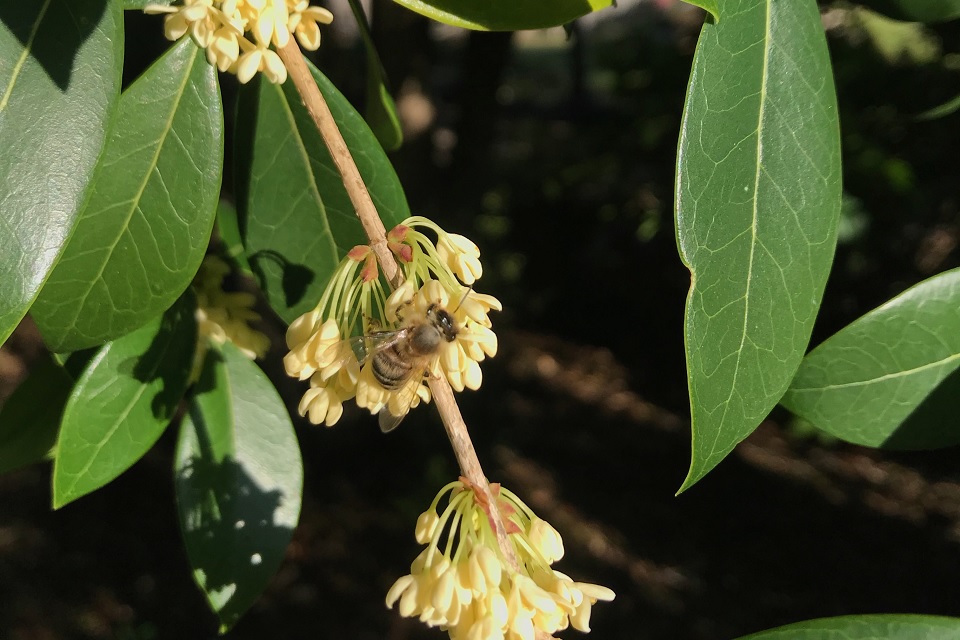
UT Gardens’ April 2020 Plant of the Month: Osmanthus
Submitted by Andy Pulte, University of Tennessee Department of Plant Sciences
Gardeners in locales more southern than Tennessee have used different members of the Osmanthus tribe for years. Southern coastal areas even have an Osmanthus species as part of their native flora (Osmanthus americanus, syn. Cartrema americana). Perhaps the recent string of mild winters has enticed us to try new plants, or maybe it’s the influence of social media and an abundance of online information that is expanding our plant palette, but Osmanthus, sometimes called the teaolive, is now finding favor in our state. I count myself among the gardeners happy to see this.
The UT Gardens, Knoxville, has a nice collection of O. heterophyllus that predates my arrival in 2005. This collection has expanded as new cultivars have come onto the market. I have to admit, I was nearly unaware of the genus before encountering it at the Gardens; however, it has become one of my favorite flowering shrubs, and I believe it will continue to find favor with Tennessee gardeners.
Often a plant’s scientific name is in honor of a famous botanist or even a well-known plant explorer. For example, Forsythia is named in honor of William Forsyth (1737-1804), a Scottish superintendent of the Royal Gardens of Kensington Palace in London and a well-known botanical author. In Osmanthus heterophyllus’ case, its name tells us about the plant itself. The name comes from the Greek words osme meaning fragrant and anthos meaning flower. The second part of its scientific name (specific epithet) comes from the Greek hetero meaning different and phyllus meaning leaf. This name is spot-on as this plant is known for intoxicatingly fragrant flowers and leaves that change shape as the plant ages. O. heterophyllus has juvenile foliage that prominently displays spiny teeth and adult foliage that nearly loses its teeth altogether.
O. heterophyllus is an evergreen shrub that most often will be 15 feet by 15 feet at maturity. It is a perfect substitute for many holly (Ilex spp.) of the same size. I suggest you use it as screening material or as a backdrop on the edges of a landscape. September through October, and sometimes as late as November, is when the fragrant teaolive takes center stage. Flowers, somewhat hidden by foliage overpower even large gardens with their fragrance. When in bloom the shrub is easy to smell from more than 400 feet away; yet, the fragrance is sweet and not overly perfumelike.
So, why would a plant known for its fall bloom be featured as a plant-of-the-month in spring? Great question. Even though O. heterophyllus grows well for us, this shrub is often best planted in the spring in Tennessee. This timing gives young plants one whole growing season to firmly establish themselves before the weather turns cool. Additionally, the energy expended producing a mega-fall-bloom could possibly leave young plants unprepared to overwinter. So, plant this shrub now, and enjoy them this fall!
A quick note: be particular when shopping for Osmanthus. A few less-hardy species often find their way into the Tennessee nursery trade, specifically Osmanthus fragrans (also called fragrant teaolive). This species is not particularly above-ground-hardy. Specimens that I have planted have died to the ground three times in ten years. Also, not all cultivars of O. heterophyllus are known to bloom as abundantly as the straight species.
You can find a variety of Osmanthus growing at the UT Gardens sites in Knoxville and Jackson, and some specimens are soon to be added to the Gardens in Crossville.
The UT Gardens includes plant collections located in Knoxville, Crossville and Jackson. Designated as the official botanical garden for the State of Tennessee, the collections are part of the UT Institute of Agriculture. The Gardens’ mission is to foster appreciation, education and stewardship of plants through garden displays, educational programs and research trials. The Gardens are open during all seasons and free to the public. For more information, see the Gardens website: utia.tennessee.edu/state-botanical-garden.